BYU Is Running The Offense Of The Future
And used it to absolutely bludgeon the troops on Monday.
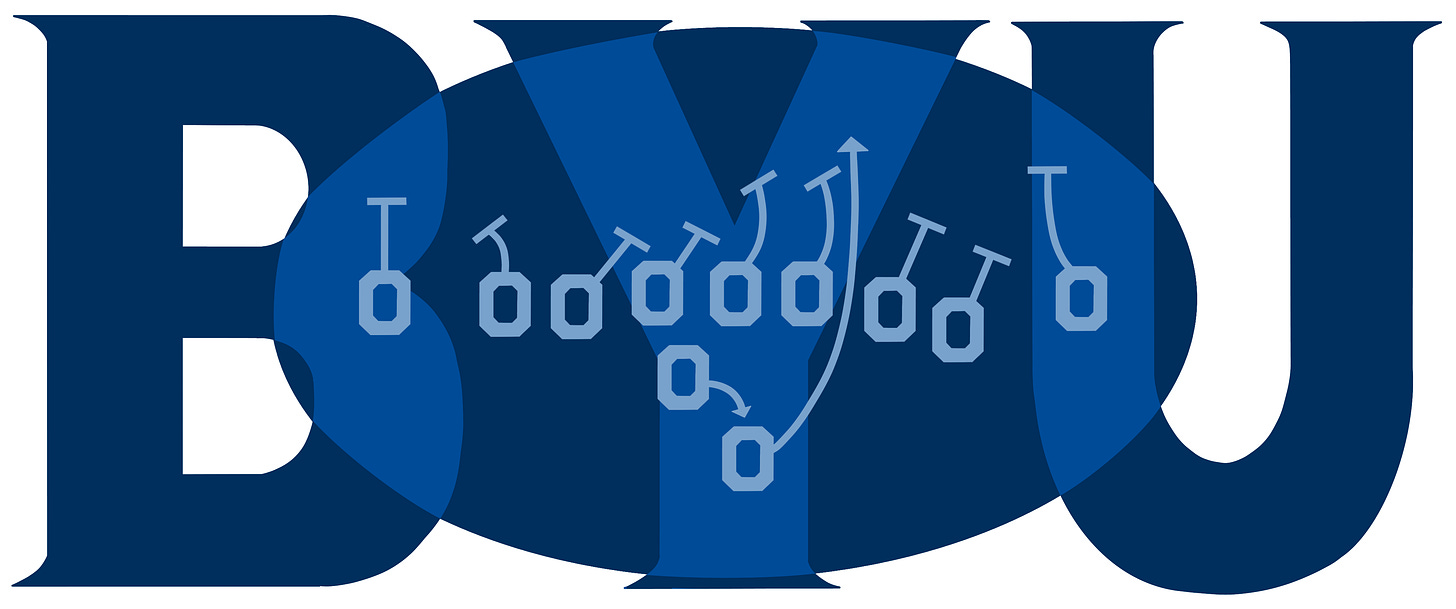
I’m calling an audible. Originally, this dispatch was set to be a look at Army’s Tyrell Robinson and his excellent performance against Middle Tennessee State, but Monday night’s BYU-Navy game has forced my hand. I have to talk about the power spread.
The power spread is essentially college football’s white whale. It’s an idea that has been talked about for years by coaches, analysts and reporters as the sport’s “next big thing” that will rise to power following the end of the spread revolution. That thinking isn’t particularly difficult to get to the bottom of, because in large part, it’s just a logical next step for the sport to take.
Basically, it goes like this: College football is inherently cyclical in its innovation patterns. Since its inception, offensive coaches have set the style for the way that the sport is played. Offenses find a weakness in the way that defense is played, exploit that weakness for several years, then defenses adapt to answer the new style of offense.
Once that happens, offenses find a new weakness and the cycle begins anew around whatever the latest innovation is. This isn’t a new concept by any means, and it’s one that I’ve covered before at length on this newsletter. It’s a fundamental part of the way that coaching works in football, but especially in college football where so much of the success of teams is dependent on winning in both strategy and talent. Even more so than high school or professional football, the college ranks breed innovation.
One of the longest cycles has been that of the spread offense, which came into power in the early-to-mid 2000s and has remained the dominant offensive system around the sport all the way through the present. It’s been so dominant because unlike a lot of the innovations of the last 50 years or so, the spread has an infinite number of branching ideologies.
Things like the wishbone, I-formation or singleback could only be modified so much, so defenses were able to adapt and find answers much quicker. With the spread, new versions and schemes are being created basically every year, which means that there’s still no real consensus on how to stop “the spread” because there’s no real definition of “the spread” other than “an offense that takes snaps primarily from the gun, with multiple skill position players on the field.” Defending the spread option is wildly different from defending the air raid, even though they fall under the same basic scheme tree.
Despite that, there is still the long-held belief in and around college football that this era of offensive prosperity will eventually come to an end, and while that end is still likely a decent way away, it does feel as though we’re nearing maximum capacity for defending these types of wide open offenses. I’m not convinced that there’s ever going to be a true answer for stopping the spread, but the fact that most teams have shifted to playing five or six defensive backs on basically every play means that we’re probably pretty close to the rise of an offense that can better take advantage of defenses being smaller and faster than they ever have been before.
That’s where the power spread comes in. The idea is, that with defenses geared so heavily towards stopping wide open passing offenses, a team that can merge that sort of passing attack with an old fashioned power running attack would be unstoppable, especially if that team was playing with blue chip talent. That’s been the “next big thing” in the sport since about 2016, when just about every top team had abandoned the power run and traded it in for a shiny spread attack.
However, despite it being the pet project of just about everyone that coaches or thinks about offense in the sport, it has yet to take hold in any meaningful way. That’s due in large part to the fact that the teams that are still playing this power style of football have been, broadly speaking, awful at it in recent years. The best example is Georgia, which never stopped playing big, dumb offense and all that got Kirby Smart was a bunch of sunburnt frat boys complaining on Twitter about five-star receivers not getting the ball enough.
Elsewhere, teams like Oregon have had at least a little more success relying on a strong dosage of the ground game, but the Ducks still have quite a few issues with efficiency and seem to be changing course anyway by hiring Joe Moorhead to run the offense. The power spread is a great theory, but up to this point, it’s really only been a theory. There’s yet to be a team that’s had success actually running counter to what almost every top offense is doing.
That’s why BYU’s performance on Labor Day caught my eye so much. The Cougars absolutely decimated a Navy team that many (myself included) expected to be pretty solid this year, and did so with something that certainly looked a lot like that idealized power spread that everyone in football spends so much time thinking about.

The version that BYU ran on Monday relied pretty heavily on zone blocking schemes when running the ball, which make a lot of sense given that it has becoming the dominant blocking scheme in college football in recent years as massive linemen become more and more horizontally mobile. Behind that, BYU used a bunch of personnel groupings and ran out of just about every formation imaginable.
Here, BYU brings out 12 personnel with the quarterback under center. The entire line is zone blocking against Navy’s four man front, leaving the back side edge rusher unblocked to pick up a numbers advantage for what looked like a six-man box at the start of the play (when you take that edge player out). The play side tight end does an excellent job of picking up the corner blitz, while the rest of the line pretty much just does what it is asked to do.
The back side tackle, guard and tight end create a nice seal to take out two defensive linemen, the play side tackle takes out the other two linemen(with the help of his tight end), freeing up the play side guard and center to slip downfield into the second level. They take out the two linebackers beautifully, the blocking the perimeter is good enough, and there’s a clear lane for Tyler Allgeier to run right through for a touchdown.
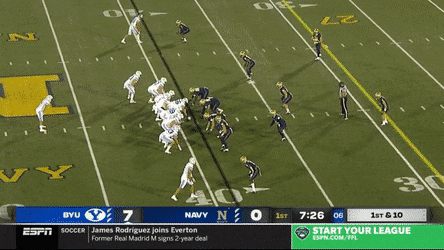
Later in the game, BYU struck again on basically the same play, running this time to the short side of the field. There’s actually a little bit of formation sleight of hand in this that you may not have picked up on during the game (I know I didn’t). Look at the back side tight end. He’s off the line, just as the tight end was on the play side of that first touchdown. BYU is on a hash mark, just as it was on the first touchdown. An observant Navy player or coach might have noticed something like that, made a call out to the rest of the team, only to see BYU run the same play to the oppposite side of the field, away from where the defense had seen the play go before.
It doesn’t seem to have a huge impact, but watch the back side safety, specifically for his first step. He steps towards the open side of the field, anticipating a run into that gap. The rest of the defense doesn’t really seem to bite, but that one false step towards the wrong side of the field was enough to put that safety a step behind the running back, which was enough to spring him for a touchdown. Little things like that can make a massive difference when you’re running the football like BYU was. If you’re going to be the big, tough, power running team, there’s no rule that says you can’t also be clever.
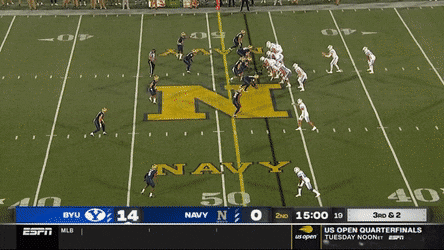
Speaking of: Here it is again. Exact same idea, this time with two receivers on the back side of the play to really sell a run in that direction (and to force the defense to dedicate three defenders to a part of the field that has nothing to do with the actual play.
This one is funny because Navy actually over plays to the correct side of the run. The line and linebackers are too enthusiastic about stopping a handoff to the outside and completely forget that BYU was running these pretty much exclusively into the play side B gap so that the halfback had an easy cutback lane if the linebackers were overly aggressive, as they were here.
Now, BYU obviously didn’t run only with this look, because even well designed plays can be stopped if you lean too heavily on them.
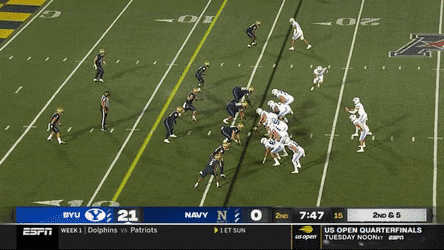
To keep things fresh, BYU also showed off some really cool motion stuff, all from the shotgun but all with different formation and personnel groupings. This first was this simple jet sweep from 12 personnel, which does a great job of making use of that personnel by using the halfback and both tight ends as lead blockers for the wideout, while dedicating four linemen to a quarterback keep fake to hold the safety and back side linebacker, along with two defensive linemen, away from the play side.
It doesn’t work perfectly here because Navy doesn’t really buy the fake, but the lead blockers play this about as well as you could possibly ask. The outermost tight end kicks out the defender trying to set the edge, clearing a lane inside of his block, while the offensive tackle sets a beautiful inside seal on the defensive tackle. With the lane set, the wideout just has to follow behind his halfback and the remaining tight end, both of whom pick up blocks on the way to a first down.
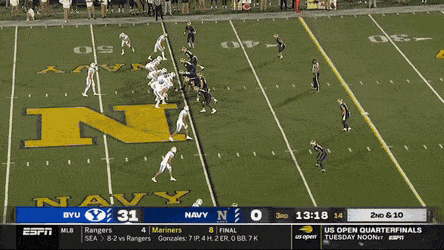
In the second half, BYU again showed motion (orbit motion this time, which goes behind the quarterback), drawing the defense to the open side of the field to stop what it assumed would be a play designed for the motion receiver. Instead, BYU just dropped Gunner Romney into a quick screen and set up shop with one of the fastest players on the field working behind the tackle and guard.
Because so much of the defense is preoccupied by the motion action, those blockers only have two defenders to immediately deal with, giving Romney enough time to get up to speed and make a play in open space.
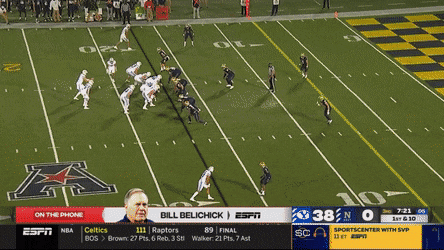
The third and final play off of motion that I’d like to touch on is this one. This is back to jet motion, like on the first play, but with 11 personnel which would indicate pass to the defense. The motion pulls an edge player out of the play and freezes the safety just enough to spring the halfback past him.
However, the part of the play that interests me most is the tight end. He sets up off the line almost as an h-back, and then blocks essentially as a fullback would. He cuts inside of the back side tackle to serve as a lead blocker for the halfback, though he’s quickly held up by a blitzing linebacker. However, this essentially gives BYU a pulling lead blocker without sacrificing any of its five zone blocking offensive linemen. If you trust your tight end to block a linebacker down the field, this is a really simple and clever way to get him into space, even if it didn’t work exactly as planned here.
Again, power running doesn’t have to mean big and dumb. I have questions about why offensive coordinator Jeff Grimes - who spent the last decade running big dumb offenses - is the one to figure this out, but I’m not going to look a gift-horse in the mouth. If BYU can keep up the creativity in its offense and refrain from leaning too heavily on the three or four plays that it trusts, this offense can work really, really well. It certainly did in week one.
Up next: Louisiana-Iowa State is the most intriguing matchup of the weekend


